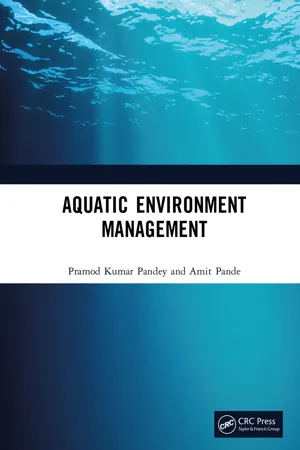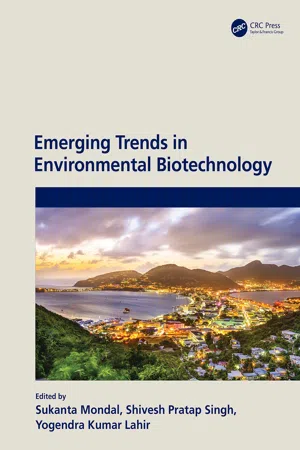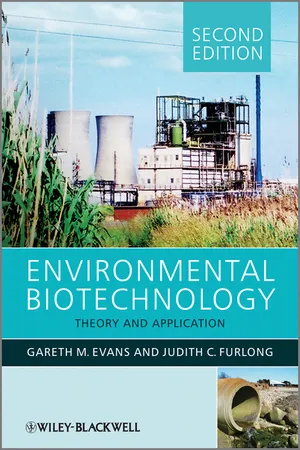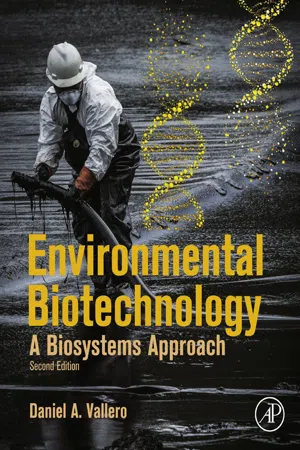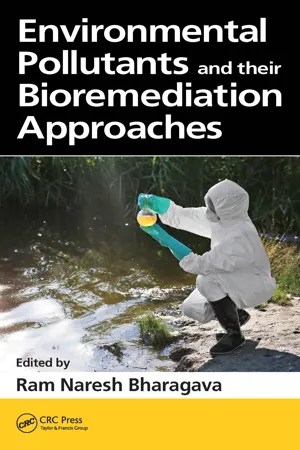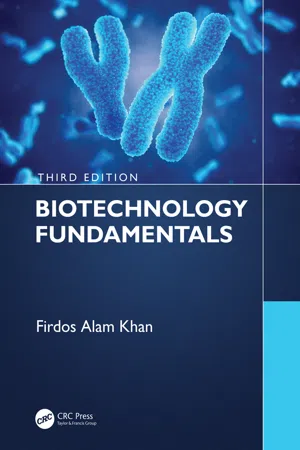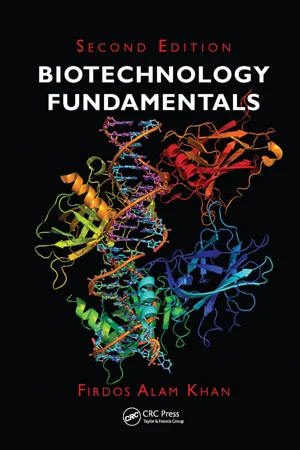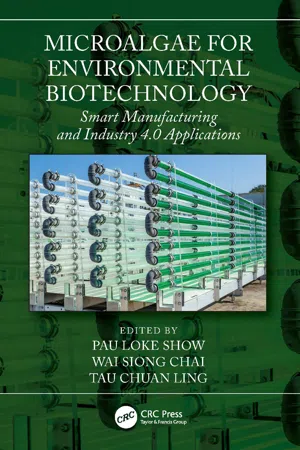Biological Sciences
Environmental Biotechnology
Environmental biotechnology involves the application of biological processes and organisms to solve environmental problems and improve sustainability. It encompasses various techniques such as bioremediation, biofiltration, and phytoremediation to address issues like pollution, waste management, and resource conservation. By harnessing the power of living organisms, environmental biotechnology offers innovative solutions for a range of environmental challenges.
Written by Perlego with AI-assistance
Related key terms
11 Key excerpts on "Environmental Biotechnology"
- eBook - ePub
- Pramod Kumar Pandey, Amit Pande(Authors)
- 2023(Publication Date)
- CRC Press(Publisher)
10 Environmental BiotechnologyDOI: 10.1201/9781003313137-1010.1 Introduction
The use of organisms, cells, their constituent parts, and their molecular equivalents for producing various goods is made possible by biotechnology, a combination of natural sciences and engineering. The production of drugs, vitamins, steroids, interferon, fermented foods and beverages, renewable energy from waste, and genetically modified plants, animals, and individuals are just a few advancements due to this most recent technological development. These developments may pave the way for the environmentally responsible manufacture of both new and traditional products. The application of biotechnology is also driven by environmental concerns for producing ecologically friendly chemicals, biomonitoring, and pollution prevention and control, such as decontaminating water, air, and soil. Biotechnology can provide more biological substitutes for products and processes that use dangerous pollutants friendly to the environment. Different sectors are drawn to biotechnology for solutions as the effects of climate change loom over our future and force us to live more ecologically friendly lives in all facets of our existence.Environmental Biotechnology employs biological processes to address environmental issues such as the genetic rescue of a species, elimination of pollutants, and production of renewable energy sources and biomass. Biotechnology may also be thought of as creating, using, and controlling biological systems like cells, cell compartments, and enzymes. These systems clean up polluted environments (land, air, water, and soil) and make good environmental processes, like sustainable development and green technologies for making different goods. Environmental Biotechnology is a fusion of science and engineering from many different fields. It uses the amazing biochemical potential of microbes, plants, and their parts to save resources and safeguard and restore ecosystems. The primary objective of Environmental Biotechnology is to optimise ways to develop sustainably and to understand how ecological systems work. An important part of biotechnology is that microorganisms can use multiple carbon sources from natural pollutants. Biotechnology has greatly affected many technologies that use biological processes in manufacturing, agriculture, food processing, medicine, and protecting the environment. It is flexible and has been rated as a very important area. Biotechnology is also used to cut reductions in waste, stop pollution, do biomonitoring, make chemicals in a way that doesn’t hurt the environment, control pollution, and clean up the soil, water, and air. Thus, Environmental Biotechnology covers many subjects, including waste management, bioremediation, biofiltration, wastewater treatment, biodegradation, and biofuel production. Complex, interacting microbial communities serve as the foundation for all these disciplines, leading to intriguing research that is increasingly being propelled by cutting-edge eco-genomic tools. However, it is still essential to understand microbial diversity, population, and structure for sustainable environmental management. As a result, exciting discoveries revealed recent knowledge gaps that eventually emerged towards active research problems and novel methodologies. The responsible use of biotechnology to help the economy, society, and environment has led to a huge leap in research. Biotechnological applications span from traditional fermentation technologies (like cheese, bread, beer, and animal and plant breeding) to modern techniques like gene technology, recombinant DNA technologies, biochemistry, immunology, molecular and cellular biology, and immunology. It has led to the efficient creation of products with low toxicity, renewable bioenergy, and other good things. - eBook - ePub
- Sukanta Mondal, Shivesh Pratap Singh, Yogendra Kumar Lahir, Sukanta Mondal, Shivesh Pratap Singh, Yogendra Kumar Lahir(Authors)
- 2022(Publication Date)
- CRC Press(Publisher)
Gavrilescu, 2010 ). Traditional biotechnological knowledge is used by the people for centuries to yield bread, wine, beer, alcohol, fermented milk products and medicines. The arenas of today’s biotechnology comprise a large spectrum of subjects like genomics, recombinant DNA technology, proteomics and bioinformatics. In the present era, the health care, agriculture, social well-being, and environmental management industries have contributed a lot to the global economy through retaining biotechnological initiatives.Environmental Biotechnology is a branch of biotechnology that is applied to the study of the natural environment. It is the efficient use of environment and natural habitats, such as animals, plants, bacteria, fungi and algae, to produce energy, including renewable energy, nutrients and food. The development process in Environmental Biotechnology includes integrated and economic profitable pathways of profit making, in which the waste of each process becomes the raw material for another process. As described by the International Society for Environmental Biotechnology, it is the development of environmentally friendly products and processes and its use, control and regulation of biological systems for redressal of polluted environment, including air, water and land or soil. The processes predominantly include green and clean manufacturing technologies and sustainable development. Environmental Biotechnology able to provide a wide range of benefits to humanity, such as new sources of renewable energy and more effective treatment of waste. Waste either solid, liquid or gaseous can be converted to less or zero waste through a recycling process and may be reused as new products or less harmful end waste. Replacing chemical materials and processes with biological technologies can reduce environmental damage. Furthermore, the application of Environmental Biotechnology has led to new products and processes that have a competitive edge over the traditional ones in terms of effectiveness, productivity, cost and safety. It has been noted that Environmental Biotechnology is the one of most rapidly growing areas in the development of economic and efficient processes with sustainability. - eBook - ePub
Environmental Biotechnology
Theory and Application
- Gareth G. Evans, Judy Furlong(Authors)
- 2011(Publication Date)
- Wiley(Publisher)
In many respects, there is a logical fit between this thinking and the aims of Environmental Biotechnology. For all the media circus surrounding the grand questions of our age, it is easy to forget that not all forms of biotechnology involve xenotransplantation, genetic modification, the use of stem cells or cloning. Some of the potentially most beneficial uses of biological engineering, and which may touch the lives of the majority of people, however indirectly, involve much simpler approaches. Less radical and showy, certainly, but powerful tools, just the same. Environmental Biotechnology is fundamentally rooted in waste, in its various guises, typically being concerned with the remediation of contamination caused by previous use, the impact reduction of current activity or the control of pollution. Thus, the principal aims of this field are the manufacture of products in environmentally harmonious ways, which allow for the minimisation of harmful solids, liquids or gaseous outputs or the clean-up of the residual effects of earlier human occupation.The means by which this may be achieved are essentially twofold. Environmental biotechnologists may enhance or optimise conditions for existing biological systems to make their activities happen faster or more efficiently, or they resort to some form of alteration to bring about the desired outcome. The variety of organisms which may play a part in environmental applications of biotechnology is huge, ranging from microbes through to trees and all are utilised on one of the same three fundamental bases—accept, acclimatise or alter. For the vast majority of cases, it is the former approach, accepting and making use of existing species in their natural, unmodified form, which predominates.The Scope for UseThere are three key points for Environmental Biotechnology interventions, namely in the manufacturing process, waste management or pollution control, as shown in Figure 1.1 .Figure 1.1 The three intervention pointsAccordingly, the range of businesses to which Environmental Biotechnology has potential relevance is almost limitless. One area where this is most apparent is with regard to waste. All commercial operations generate waste of one form or another and for many, a proportion of what is produced is biodegradable. With disposal costs rising steadily across the world, dealing with refuse constitutes an increasingly high contribution to overheads. Thus, there is a clear incentive for all businesses to identify potentially cost-cutting approaches to waste and employ them where possible. Changes in legislation throughout Europe, the US and elsewhere, combined with growing environmental awareness and a burgeoning demand for reduced carbon footprints have inevitably driven these issues higher up the political agenda and biological methods of waste treatment have gained far greater acceptance as a result. For those industries with particularly high biowaste production, the various available treatment biotechnologies can offer considerable savings. - eBook - ePub
Chemistry and Chemical Engineering for Sustainable Development
Best Practices and Research Directions
- Miguel A. Esteso, Ana Cristina Faria Ribeiro, A. K. Haghi, Miguel A. Esteso, Ana Cristina Faria Ribeiro, A. K. Haghi(Authors)
- 2020(Publication Date)
- Apple Academic Press(Publisher)
Biotechnology is the broad area of biology involving living systems and organisms to develop and make a product or any technological application that uses biological systems, living organisms, or derivatives to make or modify products or processes for specific use. Research frontiers in the field of biotechnology are of tremendous importance as civilization moves forward. Bio-engineering and biomedical engineering are the challenges and the vision of research paradigm in today’s world. Depending on the tools and applications, biotechnology often overlaps with the fields of molecular biology, bio-engineering, biomedical engineering, biomanufacturing, molecular engineering, and so forth. For thousands of years, civilization has used and developed biotechnology in agriculture, food production, and medical science. Today biotechnology has expanded to include new and diverse areas of science and technology such as genomics, recombinant gene techniques, applied immunology, and development of pharmaceutical therapies. Scientific retribution and deep scientific provenance form the backbone of biotechnological research and development initiatives globally. The vast and wide concept of “biotechnology” encompasses a wide range of processes for modifying living processes according to human purposes. The challenges, the vision, and the targets of biotechnology applications in modern science are absolutely inspiring and far-reaching. In this well-researched treatise the author reiterates the scientific success, the vision, and the purpose of biotechnology and its applications in human scientific progress. This treatise explains in minute details the interface of environmental sustainability with biological sciences and biotechnology. Technological travails in modern civilization are immense as regards biological treatment of industrial wastewater - eBook - ePub
Environmental Biotechnology
A Biosystems Approach
- Daniel A. Vallero(Author)
- 2015(Publication Date)
- Academic Press(Publisher)
opportunity risks . Therefore, it is important and crucial to treat every aspect of biotechnology objectively and in a scientifically credible manner. Many sources either support or condemn biotechnology. The attempt here is to provide a balanced and comprehensive consideration of all aspects of Environmental Biotechnology.Since Environmental Biotechnology is a confluence of many disciplines, both the environmental and biotechnological aspects must are important. In fact, despite the growth of environmental science and engineering over recent decades, complete unanimity is lacking as to what is meant by many important environmental terms. Pollution, contamination , hazard, risk, and other key environmental terms have various meanings within the environmental scientific community. Thus, after a brief introduction of biotechnologies, we will discuss a number of environmental concepts so that, at least in this work, we have agreement on vernacular and basic science.Terminology
Distinguishing “environmental” science and engineering from other scientific endeavors often hinges on what is important. For example, the general definition of biology is that it encompasses everything to do with the study of living things. Thus, what a biologist considers important is influenced by his or her specialization . Biology must be subdivided into more specific fields. Moving toward our specific focus, we are predominantly interested in environmental biology, which is the study of living things with respect to their surroundings. Generally, biologists tend to be more interested in living things as subject matter, whereas bioengineers are more concerned in living things with respect to solving problems. The bioengineering danger is the view that all things, including living things, are merely objects that should be manipulated to achieve some end. Both lay and scientific concern about biotechnologies and especially about synthetic biology stems from the seemingly exclusively utilitarian view of living systems. So, a biological process may only be seen as unacceptable if it does not meet the stated objective, e.g., converting a given mass of polychlorinated biphenyls - eBook - ePub
Soil and Groundwater Remediation
Fundamentals, Practices, and Sustainability
- Chunlong Zhang(Author)
- 2019(Publication Date)
- Wiley(Publisher)
Box 9.1 ). Since bacteria are the major players in bioremediation and Environmental Biotechnology, our emphasis will be the bacterial growth, bacteria‐mediated reaction kinetics, and pathways relevant to bioremediation. Fungi‐ and plant‐based remediation will be only briefly described for special applications.Box 9.1 Environmental Biotechnology
Biotechnology has various applications in fields of agriculture, medicine, food, drug, energy, industrial production, and environment protection. Environmental biotechnologies are the applications of primary microorganisms and sometimes plants and their products in the prevention and control of environmental pollution through biotreatment of solid, liquid, and gaseous wastes, and biomonitoring of environment and treatment processes.In a broad sense, environmental biotechnologies include the well‐established field of biological treatment of wastewater such as activated sludge system that was invented and first employed in England in 1914, and the microbe‐based landfill system such as the Fresno Municipal Sanitary Landfill, opened in Fresno, California in 1937, which is considered to be the first modern sanitary landfill in the United States. Environmental biotechnologies also include centuries‐old composting technology that was used to dispose of solid wastes and later evolved to treat hazardous wastes.Although the subject of Environmental Biotechnology is loosely defined in the literature, it is in general consensus that bioremediation falls in one of the major applications of environmental biotechnologies. The term bioremediation is commonly reserved for the treatment of soil and groundwater. While bioremediation can be referred to microbe‐based oil spills in surface water remedy, it is rarely used to refer to conventional technologies for the biological treatment of domestic and industrial wastewater. An example of these bioremediation techniques include, but are certainly not limited to, in situ and ex situ soil and groundwater treatment methods listed in Table 6.4 - Ram Naresh Bharagava(Author)
- 2017(Publication Date)
- CRC Press(Publisher)
Thassitou and Aryanitoyannis 2001 ).The agricultural field has seen major progress with the use of genetically engineered organisms, which seems to be a very important tool for producing food for those in undeveloped countries using nonhosted areas. Industrial and Environmental Biotechnology are taking new paths, resulting in processes with clean technologies, with maximum production and fewer residues (Soccol et al. 2003 ; Ezezika and Singer 2010 ).The field of biotechnology can be divided into four divisions: biomedical, agricultural, environmental, and industrial. Several works have been published that define the applications of bioremediation and physical, chemical, and biological conditions necessary to facilitate contaminant biodegradation (Romantschuk et al. 2000 ). Plant genetic engineering through inserting or overexpressing specific genes in the genome of the plants provides an efficient method to enhance the phytoremediation capacity of plants (James and Strand 2009 ; Ezezika and Singer 2010 ). Bioremediation is a function of various factors: the existence of a microbial population capable of degrading contaminants; contaminant bioavailability to microbes; environmental factors such as temperature, pH, and nutrients (organic, inorganic, and their availability); electron acceptor(s); redox potential; water activity; osmotic pressure; and concentration of contaminants (Thakur 2004 ; Al-Sulaimani et al. 2010 ; Kang 2014- eBook - ePub
- Firdos Alam Khan(Author)
- 2020(Publication Date)
- CRC Press(Publisher)
Table 8.4 ).8.3.1 Bioremediation
Bioremediation can be defined as any process that uses microorganisms such as fungi, green plants, or their enzymes to return the natural environment altered by contaminants to its original condition. Bioremediation may be employed to attack specific soil contaminants, such as degradation of chlorinated hydrocarbons by bacteria. An example of a more general approach is the cleanup of oil spills by the addition of nitrate and/or sulfate fertilizers to facilitate the decomposition of crude oil by indigenous or exogenous bacteria. Naturally occurring bioremediation and phytoremediation have been used for centuries. For example, desalination of agricultural land by phyto-extraction has a long tradition.Bioremediation technology using microorganisms was reportedly invented by George M. Robinson. Bioremediation technologies can be generally classified as in situ or ex situ. In situ bioremediation involves treating the contaminated material at the site, whereas ex situ bioremediation involves the removal of the contaminated material to be treated elsewhere. Some examples of bioremediation technologies are bioventing, land farming, bioreactor, composting, bio-augmentation, rhizofiltration, and biostimulation. However, not all contaminants are easily treated by bioremediation using microorganisms. For example, heavy metals such as cadmium and lead are not readily absorbed or captured by organisms. The assimilation of metals such as mercury into the food chain may worsen matters. Phytoremediation is useful in these circumstances, because natural plants or transgenic plants can bioaccumulate these toxins in their above-ground parts, which are then harvested for removal. The heavy metals in the harvested biomass may be further concentrated by incineration or even recycled for industrial use. The elimination of a wide range of pollutants and wastes from the environment requires increasing our understanding of the relative importance of different pathways and regulatory networks to carbon flux environments and for particular compounds, and this will certainly accelerate the development of bioremediation technologies and biotransformation processes. - eBook - ePub
- Firdos Alam Khan(Author)
- 2018(Publication Date)
- CRC Press(Publisher)
Chapter 8 Environmental Biotechnology Learning objectives • Discuss the importance of a healthy environment. • Discuss some factors affecting the environment. • Explain the role of biotechnology in maintaining the planet. • Explain how the bioremediation helps clean wastewater. • Discuss some environmentally friendly products such as biofuel, biodegradable plastic, oil-eating bacteria, biostimulation, bio leaching, vermitechnology, and biosorption. 8.1 Introduction We should first know the environment (Figure 8.1) and its components before we discuss the factors that affect it. These components can be classified into two major types: living components and nonliving components. The first components pertain to natural systems without massive human intervention, such as vegetation, animals, microorganisms, soil, rocks, the atmosphere, and the natural phenomena that occur within their boundaries. The second components pertain to universal natural resources and physical phenomena that lack clear-cut boundaries, such as air, water, and the climate, as well as energy, radiation, electric charge, and magnetism that do not originate from human activity. 8.1.1 Ecosystem An ecosystem is a natural unit consisting of all plants, animals, and microorganisms in an area functioning together with all the nonliving physical (abiotic) factors of the environment. The living organisms are continually engaged in a highly interrelated set of relationships, with every other element constituting the environment in which they exist. The human ecosystem concept is then grounded in the deconstruction of the human/nature dichotomy and the emergent premise that all species are ecologically integrated with each other, as well as with the abiotic constituents of their biotope. Ecosystems can be grouped and discussed with tremendous variety of scopes. An ecosystem can also describe any situation where there is a relationship between organisms and their environment - eBook - ePub
Microalgae for Environmental Biotechnology
Smart Manufacturing and Industry 4.0 Applications
- Pau Loke Show, Wai Siong Chai, Tau Chuan Ling, Pau Loke Show, Wai Siong Chai, Tau Chuan Ling(Authors)
- 2022(Publication Date)
- CRC Press(Publisher)
5 Understanding Environmental Biotechnology 4.0Wai Yan Cheah1 , Tengku Nilam Baizura Tengku Ibrahim2 , Nurul Syahirah Mat Aron3 , Wai Siong Chai4 and Pau Loke Show3 ,*1 Centre of Research in Development, Social and Environment (SEEDS), Faculty of Social Sciences and Humanities, Universiti Kebangsaan Malaysia, 43600 Bangi, Selangor, Malaysia2 Department of Environmental Health, Faculty of Health Sciences, Universiti Teknologi MARA, Cawangan Pulau Pinang, Kampus Bertam, Kepala Batas, Penang, Malaysia3 Department of Chemical and Environmental Engineering, Faculty of Science and Engineering, University of Nottingham Malaysia, Jalan Broga, Semenyih, Selangor Darul Ehsan, Malaysia4 School of Mechanical Engineering and Automation, Harbin Institute of Technology, Shenzhen, Guangdong, ChinaDOI: 10.1201/9781003202196-5Contents
5.1Introduction 5.2Understanding Industrial Revolution 4.0 5.3The Advancement of Environmental Biotechnology in Industrial Revolution 4.0 5.4Biomass to Biofuel Conversion Technologies 5.5Conventional Pretreatment: Physical, Chemical, and Biological Pretreatment 5.5.1Physical Pretreatment 5.5.2Chemical Pretreatment 5.5.3Physico-Chemical Pretreatment 5.5.4Biological Pretreatment 5.5.5Novel and Emerging Technologies: Ionic Liquid and Hydrothermal Pretreatment 5.6Biofuel Conversion Technologies 5.6.1Biochemical Conversion 5.6.2Thermochemical Conversion 5.7Pollution Control, Prevention, and Cleaner Production 5.7.1Wastewater Treatment 5.7.2Organic Pollutant Removal 5.7.3Heavy Metal Removal 5.7.4Micropollutant Removal 5.7.5Air Pollution Control References5.1 Introduction
Industrial revolution had brought tremendous positive effects and challenges to all countries and human race. The transformation has been led by Great Britain with the invention of the commercial steam engine. The invention has brought industrial developments due to the improvement in communication and transportation. First industrial revolution was followed by second industrial revolution which was led by United States, with the invention of telephone, revolutionizing the art of communication during that era. The development has evolved further to third industrial revolution, with the invention of Internet communication. With the public infrastructure built, the Internet has transformed the economic landscape in all sectors. All these industrial revolutions, undeniably, have brought impactful economic growth, increase in productivity and quality goods as well as services, improved social development, and the overall advancement in the well-being of the society. Conversely, there are also challenges arisen, with the most significant one including environmental degradation. Resources’ depletion, climate change, and global warming have resulted from rapid economic growth and industrialization, with excessive utilization of fossil fuels. Thus, moving towards sustainability in overall, pillars of social equity, economic viability and the environmental protection are vital to reach the ‘balance’. - eBook - ePub
- Daniel H. Chen, Daniel H. Chen(Authors)
- 2016(Publication Date)
- CRC Press(Publisher)
1 ], leading to an increasing number of extreme urban environments called megacities. Hence, within a very short time, established and proven urban water treatment facilities will be challenged to the limit by denser waste streams, new emerging contaminants, and generally increasing costs for wastewater monitoring and treatment. Biotechnology takes advantage of the creativity shown in biological systems to solve engineering problems and to fulfill industrial tasks. It represents a promising possibility to quickly broaden the availability of powerful applications for water monitoring and treatment necessary to guarantee safe and also sustainable water under those circumstances. This chapter will first introduce biosensor technologies as a means to detect and evaluate potentially toxic compounds in water bodies. It will then highlight two remarkable biotechnological methods to eradicate contaminants for sustainable drinking water and a healthy environment.10.2 BIOSENSOR TECHNOLOGYIn many developed countries, people regard provision of safe water as a matter of course. An increasing number of frameworks and directives have therefore been brought into operation that identify and group substances together, which are of major concern for the aquatic environment. Such high-risk substances are controlled on a regular basis by a multitude of sophisticated analytical methods, of which the various types of mass spectrometry are of particular importance [2 ]. However, the supply of safe water is continuously exacerbated through emerging contaminants that originate as products of our everyday lifestyle (e.g., consumption of pharmaceuticals and use of personal health products) and under certain conditions such as the reuse of water in extreme environments like megacities [3 ]. Even though progress has been made in recent years, mass spectrometric techniques still encounter difficulties when it comes to identification of nontarget compounds and unknown degradation products because either analytical standards or appropriate reference databases are missing [2
Index pages curate the most relevant extracts from our library of academic textbooks. They’ve been created using an in-house natural language model (NLM), each adding context and meaning to key research topics.
